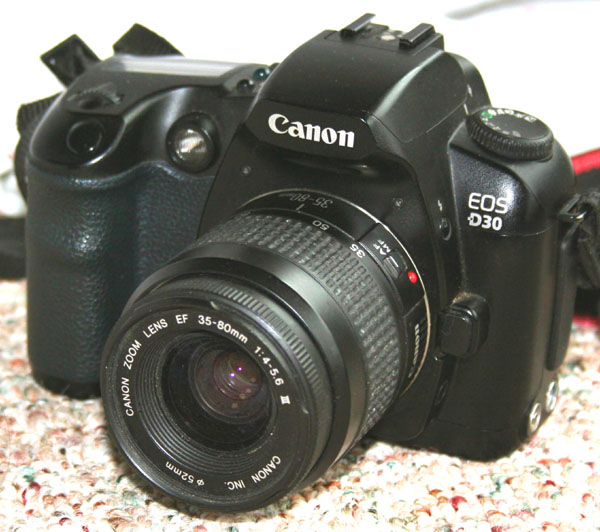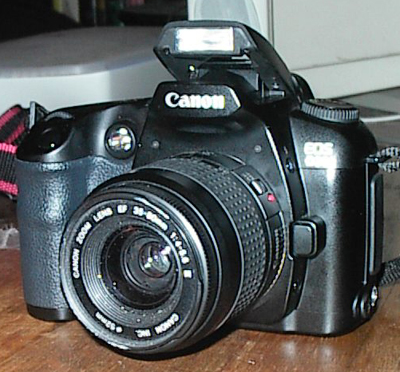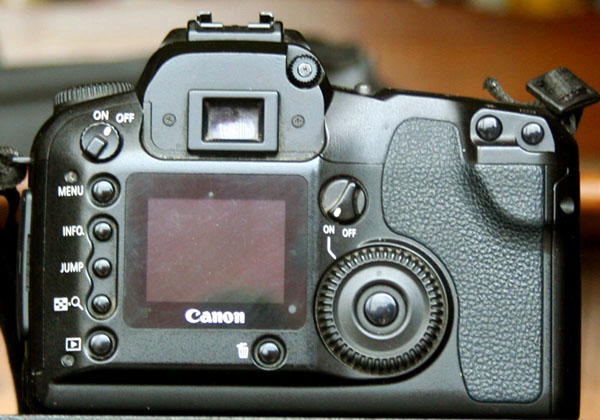The Canon D30

|
Type | Digital SLR |
| Shutter Range | 1/4000 to 30 seconds | |
| Shutter Type | Vertical Travel, Electronically Timed Focal Plane | |
| Meter Type | Silicon 35 zone (capable of semi spot) | |
| Meter Range | EV 2 to EV 20 | |
| Exposure System | Multimode AE, and manual | |
| Lens Mount | Canon EF Autofocus | |
| Battery | BP-511 |
|
|
||||
| Sensor Type | CMOS | |
LCD Display | 1.8" color 144K pixels |
| Sensor Size | 22.7x15.1 mm | Recording Media | Compact Flash | |
| Sensor Resolution | 2226x1460 (3.25MP) | File Size | 1.3 mb to .4 mb | |
| Focal Length Compensation | 1.6 | Film Speed Equiv. | ASA 100-ASA1600 | |
This was not the first digital SLR ever made, but it was the first to be made at a price to put it in reach of the serious amateur, or self employed professional. Kodak had made a number of digital SLR's based upon various film cameras produced by some of the leading camera makers. These cameras used Kodak's own integrated sensor, and memory back and were far too expensive for any but the most affluent and demanding users. Generally these were wire services, or other news agencies. For this type of user, getting the photos, and transmitting them over the wires, gave an immediacy which put the competition at a great disadvantage. The news gatherer who had to depend upon getting film developed, and shipped, would find himself scooped every time.
Though at a price of $3000 at it's introduction, the D30 was hardly cheap, compared to the $20,000 or so that the Kodak specials cost, it was a real temptation. Street price on these cameras soon fell to about $2500, and then to around an even $2000. This was not too far away from the cost of a top of the line SLR film camera. At the time of this writing, Canon has introduced it's new D60 camera, at a street price of $2200-$2500. This is not expected to cause the prices of the D30 to fall sharply for a while, because of the backlog Canon has in filling D60 orders. When the smoke clears, cost of the D30 will probably hover around $1500, while that of the newer model will be around $2000. What these cameras have done, along with similar offerings by Nikon, and Fuji, is to make the make available, at an affordable price, a digital camera respectable for serious work.
Considering that this is a professional grade camera with high resolution and the flexibility of the full range of Canon lenses,
 there are a number of features meant to appeal to the casual, or snapshot
photographer. The autofocus feature comes to mind, as does the option for
fully programmed exposure. There is also a series of AE settings collectively
referred to as the Easy Shooting Zone. Each member of the series is pre
programmed to give good results taking the following types of shots:
there are a number of features meant to appeal to the casual, or snapshot
photographer. The autofocus feature comes to mind, as does the option for
fully programmed exposure. There is also a series of AE settings collectively
referred to as the Easy Shooting Zone. Each member of the series is pre
programmed to give good results taking the following types of shots:
- Portrait (Low Aperture, center spot metering)
- Landscape (High Aperture, averaging metering)
- Close up
- Sports (high shutter speed)
- Night scenes (Auto flash, combined with slow shutter speed)
The Creative Zone, is what Canon calls it's series of more traditional, non programmed exposure modes. These modes are
- Manual exposure
- Aperture Priority
- Shutter Priority
- Automatic Depth of Field
The images are stored on Compact Flash media. Type I and type II are supported, meaning that the user has an option to go with the remarkable IBM microdrive. The microdrive is a tiny 1" hard drive unit which will hold up to 4 gigabytes. The camera comes standard with a nearly useless 16mb Compact Flash module, which will hold 12 pictures, at the highest quality, or 40 at the lowest. The microdrive comes in sizes of 340mb, 512mb, 1 gb, 2.4 gb, and 4gb. I have seen standard, solid state Compactflash cards in sizes as large as 512mb.
The heart of any digital camera is it's imager. The imager, and the storage media combine to do the same job as the film of a conventional camera. In the D30, this is a small CCD unit, developed by Canon for still photography. CCD units are very popular in camcorders, though they had not been previously used for still cameras because of some technical problems regarding noise. In video work this noise is not noticeable enough to be objectionable, but still photography makes the eye more critical. Canon claims to have solved the noise problems, and this does seem to be the case. The photographs taken with the D30 are rich, crisp, and clear. The only noise I noticed was a bit of interlace from a black cloth background. I am working on a page comparing the quality of today's films with that of the top of the line digital cameras. The results surprised me. In summary, these imagers are nearly as good as film, and can actually surpass film, when the variations of developing, and printing are taken into consideration. Of course, this is only for picture that will be displayed digitally. If the pictures are printed out, there is a limitation of quality dependent on the printer. Hardcopy of digital photographs is somewhat inferior to that of film photography, particularly if the film photograph is developed by hand, using the skills of an experienced printer.
| The Effect of
Film Speed on Image Quality of the D30 |
||

ASA 400 (cropped down from a much larger photo) |
A friend as he looks in average room lighting.
Note that the ASA 1600 photo lacks the resolution, and color rendition of
the ASA 400. Note also that the ASA 400 photo is a bit less sharp, due to
the lower shutter speed required. |

ASA 1600 (cropped down from a much larger photo) |
| The
imager of the D30 is capable of operating at film speeds ranging from ASA
100 to ASA1600. The higher film speeds bring with them the traditional disadvantages
well known to generations of film photographers. Chief among these are
noise, and reduction of gray scale. In film cameras, this is produced by
the need for larger, more irregular grains of silver halide, needed to
work with smaller amounts of light. This tends to make the pictures granier.
On digital cameras, noise is an artifact of the natural, random signals
given off by the sensor. These signals are generally below the threshold
of the signals produced by the light striking the face of the sensor, and
are overpowered by them. As the light intensity drops, these lower level
signals become noticeable. Another problem of operating at low light levels,
using fast film, is the problem of loss of contrast, and color saturation.
still, a higher ASA rating will get you a picture that might not be possible
with a lower setting. |
||
One of the ways that digital cameras can fight back, and get more versatility, is by the use of film speed settings, and quality settings (parameters can also be used, but I do not use them, or know enough about them to really comment). This give the user a bit of versatility, though not to the degree of that enjoyed by the film photographer. Still, the technology is moving along, and who can say what types of imagers might be a few years down the road. Of course, film and chemical technology are not standing still either. It will be interesting to see what development lie ahead in both areas.
| The Effect of Image
Quality Settings on the Canon D30 |
||
High Quality |
These two photos are taken of the exact same subject,
with the exact same exposure, under the exact same conditions. Only the quality
level has been changed. Some added detail loss can be seen in the cross
hatch pattern (this is a photo of a Fresnel lens) in the average quality
image. |
Average Quality |
| In addition to the film
speed setting, the D30 offers the option of two resolutions, and two quality
levels. The purpose of different levels of resolution is intuitively obvious.
The selection of quality levels is not really an artistic or an adaptive
control. The main function of the selection of quality levels is to give
the photographer some control over the file size of the images produced.
This is done by selecting between different levels of compression when the
images are being stored. In the D30, images are generally stored in the JPEG
format, which is a compressed format. Compressed format use algorithms to
look for patterns so that they can throw details away, and give smaller file
sizes. These same algorithms are used when the image is viewed, to reconstruct
the details that were taken out. Naturally, nothing conforms exactly to
any pattern or algorithm, and bits of the detail will not be reconstructed.
At higher compression levels, you get smaller files, but less accurate reconstruction
all the fine details. The more irregular, textured, or busy a scene is,
the more the compression effect will be noticed. The best candidates for
high compression are sunsets, and wide open vistas. The worst subjects for
high compression are diagrams, printed pages, or anything with a considerable
amount of detail or contrast. |
||
 types of situations. This is what makes the Easy Shooting Zone settings
possible. So for landscapes, the metering pattern will be bottom weighted,
under the assumption that the upper portions of the frame will be filled
by the relatively bright sky. For portraits, semi spot metering will guarantee
that a face which fills the center of the composition, as is the case in
most portraits, will be perfectly exposed. For Close ups, center weighted
is just the thing. My favorite feature is a resurrection, of sorts, of the
old TTL semi spot metering of the old F series. When this option is chosen,
the EOS series does the old FD cameras one better by using a 9.5% circle,
as opposed to the FD 12% rectangle. This is the only metering setting that
I use.
types of situations. This is what makes the Easy Shooting Zone settings
possible. So for landscapes, the metering pattern will be bottom weighted,
under the assumption that the upper portions of the frame will be filled
by the relatively bright sky. For portraits, semi spot metering will guarantee
that a face which fills the center of the composition, as is the case in
most portraits, will be perfectly exposed. For Close ups, center weighted
is just the thing. My favorite feature is a resurrection, of sorts, of the
old TTL semi spot metering of the old F series. When this option is chosen,
the EOS series does the old FD cameras one better by using a 9.5% circle,
as opposed to the FD 12% rectangle. This is the only metering setting that
I use. The photographer has two ways to view his work. The first, and most obvious, is through the viewfinder. As a reworked SLR, the D30 has a regular eye level, pentaprism viewfinder for through the lens viewing via a ground glass screen. The eyepiece has a dial to give up to 2 diopters of visual correction, for users who wear glasses. The viewfinder itself displays the three focusing marks (user selectable, of course), along with shutter, aperture, flash, and autofocus information. There is also a slightly shaded ring, which shows the metering area when semi spot metering is selected. What is missing from the viewfinder, in this autofocus camera, is any kind of focusing aid. This can make precise focus with a non autofocus lens, rather difficult, particularly when using slow lenses.
To check photographs already taken, there is a built in color LDC screen on the camera back. The screen can not be used to compose or preview photographs, as it only displays what has already been stored in the memory. The resolution of 300x480 (144,000 pixels) is about half that of a standard VGA monitor, and not too far inferior to that of the sensors on cameras from just a couple of years ago. There is more to the LCD screen than a fancy way to view your images. The images can be zoomed in on, and the screen can also be used to view camera settings. On top of all of this, Canon has included a way to display histograms, charts of color balance, brightness, contrast etc., on this display. This is not a feature that I use, preferring to view and adjust these levels in Photoshop (if at all), but some users might find them convenient.
Two dials control most of the operations of the camera. The dial to the left of the pentaprism, selects the shooting mode, while the dial to the right sets the exposure. It is possible to use the camera, while never touching another control, other than the power switch. For those who enjoy a bit more creative control of their image, the D30 is able to oblige. In addition to the easy Shooting Zone Settings, and the Creative Zone settings, the camera has exposure compensation, and the option of setting parameter definitions, which allow for customizing the color balance, brightness, contrast, and intensity. Different sets of parameters can be defined as sets, so that the demanding photographer can create a special parameter set for indoor lighting, another for cloudy days, and still another for bright sun.
Personal Observations:
While I have a certain preference for manual exposure, under most circumstances, I have never cared for autofocus at all. Most photographers can do the job
The D30 has a built in flash, which pops up from the top of the pentaprism housing when the camera meter decides that it is needed. The unit is fully integrated with the camera meter system, and has an ASA100 rating of 39. This is more convenient than I had first thought, and the flash comes in very handy for snapshot type photography, and even more handy as a fill flash for taking some of the contrast out of brightly lit scenes. For the more demanding or flash dependent photographer, Canon offers a number of very capable flash units which are able to fully integrate themselves with the camera's metering, and focusing systems.
My best friends on this camera, are the exposure hold button, and the manual override. The exposure hold button is the easiest way to get by the computer automation, or to photograph off center subjects, and still get a proper exposure. There is also an exposure compensation system, for backlit, offset, or oddly colored scenes, but I have never had good results with exposure compensation; it takes too long, and requires too much guesswork. The manual override is usable, but not as certain as an old fashioned match needle camera. The problem with the manual override, is that it allows the camera to be set with the controls, but does not allow for full use of the camera meter during manual operation. Even so, it is good enough when I need it, and is a step in the right direction.
The thing that really sold me on this type of camera, is it's ability to go all day without the need to be reloaded. The 721 image capacity that the 1gb microdrive gives this camera, is like having 20 standard 36 exposure rolls of film on tap. On a recent vacation, I was able to shoot every day, downloading my images into a laptop at night, and never worry about running out of film. I was also able to see the results of the day's shooting, without having to take film in for development, and waiting for it to come back. With smaller image sizes, I can take 2884 photos on a single 1gb drive. Drives as large as 4gb are now available. Though the battery is rated at only 500 photos, extra batteries can be carried, or the battery grip can be used. On my trip to the Grand Canyon, I brought along a lap top computer, and puled the day's images off of the camera every night, giving me as fresh drive every morning. I took over 3000 photographs, and never had to worry about running out of film. I also did not have to worry about enduring my yearly vacation ritual of going down to the camera store, and grabbing dozens of envelopes, putting
The camera comes with a battery, charger, and AC adapter. The as adapter works by plugging into a receptacle on the charger. Once connected, the adapter goes into the camera battery compartment. Canon also offers a cigarette lighter adapter, and a power grip, which allows the camera to operate off of two batteries at once. The power grip attaches a bit like a motor drive, and plugs into the battery compartment of the camera, while holding two standard batteries. There is a radio controlled remote unit, and numerous flash options. The most important accessory is the availability of the entire series of Canon EX lenses.
The down side:
Nothing is perfect, of course, and there are a few small complaints I have about the D30. With the exception of the sometimes odd color rendering, these are mostly a matter of personal preference.
- Colors can be weird, and oversaturated.
- Being an autofocus camera, there are no viewfinder focusing aids.
- Autofocus is slow, and does not work in low light.
- Manual exposure setting can take some getting used to.
- It would have been nice if the meter had true low light capability,
though this may be moot, because of the limitations of the sensor. Better
low light performance would be nice.
Still, all things considered, I am unlikely to return to film, except
for a few specialized uses (like night photography).
D60 Links (The Future)
Canon has, since the D60, introduced the 10D, 1D, and Digital Rebel. All of these new cameras have higher resolution imagers, and all are directed towards different markets. The Digital Rebel has a 6 megapixel imager, and is rather lightly constructed. It is claimed to have a much better autofocus system than the burdensome type slowing the performance of the D30. The D60, 10D, and 1D are all more heavily constructed, more along the lines of the D30. The 10D, and 1D are marketed as pro grade cameras with sturdier metal frames. Other models are certainly on the way.
I will eventually get a partner for my trusty D30, but it is not a pressing need. First I will probably get a larger micro drive, and perhaps a more powerful flash unit. I would also get a wider lens, something which would be much more useful than another camera body. I might also decide to wait awhile, until Canon comes out with a lower priced model with a full frame imager. This would make focal length compensation factors a thing of the past, and will greatly extend the usefulness of my wide angle lenses.
| Powershot D60 | PC Magazine Review | Digital Preview | Steve's Review |